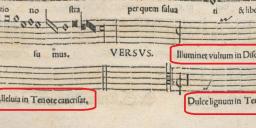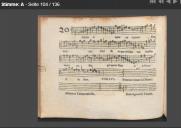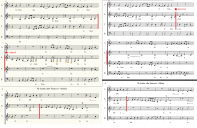Isaac's Choralis Constantinus
-
This is really odd.
I finished my Corpus Christi works, and pulled up my Finale file for the introit: Nos autem (which it says I last opened at the beginning of February).
Even though it looks like I had already checked the music well enough to have switched all the clefs, and I had already added the text to the last phrase of the antiphon and to all of the verse... this isn't the right music.
It isn't even almost the right music, except for the incipit of the antiphon and verse. And yet I have set the text... I feel like I must be crazy, but I don't understand how this happened or to what actual introit this music belongs...
 Holy Cross.png3840 x 1080 - 1MThanked by 1tomjaw
Holy Cross.png3840 x 1080 - 1MThanked by 1tomjaw -
Oh wait. I found it... it's from CC3, and I had opened CC2. *facepalm*
Thank goodness!
So, @tomjaw, for which setting were you interested? -
Both of these introit settings are now available: Nos autem (introit).
I have a question, which may be silly:
When there is not a part written in one partbook or another, but instead it mentions something like that something can be found in another part, what exactly does that mean?
ex. "In tenore cancrisat." It can't mean that the tenor is "cancerous..." so how does one find out from where certain parts of DTO and other such partbook transcriptions come?
It must be obvious, and I'm just not seeing it (I spent time on composition in college, but I'm drawing a blank), but the alto parts aren't just harmonizing the discantus or tenore parts, so where do their parts come from in the DTO editions?
 example.jpg917 x 365 - 125KThanked by 1tomjaw
example.jpg917 x 365 - 125KThanked by 1tomjaw -
Reminds me of trying to puzzle out Freimauer the first time I read Woyzeck: not a wall but a mason. Try crab instead.Thanked by 1CCooze
-
Corinne,
Without the context (I'm not the specialist) I have a thought on the the Dulce lignum and Illuminet vultum.
Is this the equivalent of saying "You won't sing now, because......"? -
I vaguely remember studying Wozzeck.
How frustrating to not recall these things as clearly as I'd like.
You're right, of course, as that specific "Alleluia" is in such form, and then the verse is in regular canon with the tenor, and the verse from the introit (illuminet vultum) was to be the same as that of the discantus, but starting on the note given by the custos.
audible sigh of relief
Thank you! As above with my forgetting from which book I had started, it's a relief when things finally make sense, as I know they should, though very distressing until that point.Thanked by 1tomjaw -
Chris, it seems to be the equivalent of saying, "now, here's a fun game for you..." ;-)
Look off this person's part, and don't sing it but sing it this way... and then look at that person's part, but sing it this way, instead.
Oh the fun [you] will have!Thanked by 1tomjaw -
I thought that "cancrisat" refers to what is also called a "crab canon" ... that is to say, a retrograde canon. Which work, in which DTO volume, does this example come from?
(I just spent some time looking but could not find this example).
-
Chuck, it's from volume 2, in the alto book.
(as the snapshot hopefully shows, it's p. 104)
 p104.jpg542 x 384 - 53K
p104.jpg542 x 384 - 53K -
Ah, I was searching volume 3. In volume 2, No. 10 (Johannis Baptiste), the Sequence (Solemni celebrantes) has "in cantu cancrisat" for the Tenor part at "Et agni velere quem tuo digito." It's a crab canon with the soprano part. Still looking for your example.
-
Ah, found it! No. 20 (De Sancta Cruce). The "Illuminat vultum in discantu" is an instruction to have the alto sing the soprano (discantus) part but beginning on the pitch indicated by the custos - in this case, down a third (soprano starts on C5, alto on A4) - so here they sing in parallel thirds.
The Alleluia indeed features a crab canon between the alto and tenor parts.
And the alto part of the "Dulce lignum..." is a canon at the unison with the tenor, delayed by two breves (as signified by the two breve rest before the custos).
Added note: I just saw your post of the alto part.
-
Corinne,
Is it possible that the aural culture was so strong in the day that, hearing a part was adequate for learning it well? (Our own time clearly doesn't pass things on in this way, but in his day, maybe?) -
Dear Corinne,
Thank you very much, while we won't have time to learn the Introit for the 3rd, we may be able to use it in September. When we have a choice of two settings I hand them over to the choir and ask them which one they want to do.
Hope to have some recordings made over the next year, just waiting for the last few Covid restrictions to be removed.
Tom -
I believe that good musicians today are equally strong in this respect as they were then, the main difference being that most of them today aren't into sacred polyphony; or at least only among many many other things... which gives you a negative selection bias.Is it possible that the aural culture was so strong in the day that, hearing a part was adequate for learning it well? (Our own time clearly doesn't pass things on in this way, but in his day, maybe?)
Two thirds of the singers of my choirs even cannot read music at all... last week one of them (40+ years of membership) asked me what the C after the clef meant...
-
Two thirds of the singers of my choirs even cannot read music at all... last week one of them (40+ years of membership) asked me what the C after the clef meant...
That's a rather common question. -
Elmar,
I don't think a really good musician can be allergic to Sacred Polyphony.Thanked by 1Elmar -
I've greatly enjoyed getting used to reading from these books, and I think that I really prefer it to the amount of ledger lines found in modern music notation. (At least for singing... I don't think I'd want the possibility of clefs changing while playing oboe, but I suppose I haven't really tried it. As long as I can remember the key signature of the piece in question, I suppose it really might not be that difficult.)
The clefs really aren't difficult to read or to sing from (especially if you've been reading chant, anyway), but I do wish that Finale had a (click-on-to-enable) sol-fa system of input, and not just "note names."
As for hearing something to know it: Many people are excellent at hearing something and singing/playing it back.
However, I'm not sure that someone could hear a part sung, and automatically sing it back to them, in reverse. I would definitely assume that you would look on with the tenor in order to sing along "in cancrisat" (as a pisces, I didn't even give a thought to "cancer" being the crab). -
I am sorry that I didn't get to these sooner, Tom.
While I know that I was under no obligation, I had intended to get to them all in a more timely fashion.
Many small and large issues compounded to delay such. Our rental agreement will soon run out, probably before our house is completed, so I may have limited access in the somewhat near future, depending moving, etc.
I'm just thankful to be back to getting some of these completed. I'm so glad that I am able to find answers to my questions from the many wonderful people who frequent this forum! -
We are currently looking at the Tu es Petrus, we should be able to do it on Tuesday! In the Future we are thinking of singing both settings, Issac 1, Psalm verse, Chant setting, Issac 1, Psalm verse, Chant setting, Psalm verse, Issac 2, Psalm verse, Chant setting, Psalm verse, Issac 2. we will see if it works!
Thank you Corinne!
Anyway I am currently working on a music plan for the choir, so I have a new wish list.
Int: Benedicta sit sancta, (Trinity Sunday)
Int: Terribilis est, (Dedication)
Com: Domus mea, (Dedication)
Int: Omnes gentes, (VII Sunday after Pentecost)
All: Omnes gentes, (VII Sunday after Pentecost)
Int: Suscepimus Deus, (VIII Sunday after Pentecost)
All: Amavit Deum, (Common of Confessors)
Com: Fidelis servus, (Common of Confessors)
Int: Salve Sancta Parens (Common of the BVM)
(It would be handy to have a version with the modern Psalm verse Eructavit)
All: Post partum, (Common of the BVM)
Com: Beata viscera, (Common of the BVM)
There is no hurry, as we will not have time to learn these new pieces until 2022!Thanked by 1CCooze -
Thanks Corinne, have just seen the Dedication propers, now we just need to learn them before the 3rd Sunday of October (Dedication of our Cathedral).
Thanks Richard for the Suscepimus, this should come in handy next year. -
Tom, I'm about half-way through this most-recent list.
Sadly, all of these introit verses seem to require text changes to fit the G.R.
I've decided that I may just start having the "original" verse set on an additional page... Perhaps someone will decide to sing the GR & Constance verses, or something. -
@CCooze
We sang the Terribilis a month or so ago, it takes a while to sing but is beautiful! We also sang the Locus Iste, Bruckner, Domine Deus, Palestrina and the Domus mea, Issac.
Tomorrow we are singing the complete set of Issac Propers for the Last Sunday of Pentecost, with Palestrina Offertory.
I think it is a good idea to have both the original and the modern psalm verses, so we can choose.
Thanks very much! -
The 2 "omnes gentes (P7)" propers required some adjustment in various ways - and I'm not above fixing my adjustments if it seems sloppy.
In the verse of the alleluia, the alto line suddenly goes quite excessively low, and the general range in the alto and tenor lines don't leave much space for adjusting the key to fit different voice configurations.
Attached, the "white" score is my adjusted score, while the "beige" is my un-adjusted version from which it came.
Please let me know if you [all] think that this particular adjustment is all right. Thanks!
 adjusted AT.png1525 x 992 - 691K
adjusted AT.png1525 x 992 - 691K -
I think the adjustment is fine. Just have some verbal note in the score explaining what you did
-
Unless I've missed something, I believe your most most recent wish-list to be complete, Tom.
-
Dear @CCooze
Thank you so much, members of our Congregation have repeatedly told me they have really found this music to be a great aid to their prayers. It is a privilege to be able to use such music for the very purpose it was composed.
Our next major project will be to spend a few days recording these and other music we sing that is sadly not to be found on the usual websites hosting recordings. I will post the fruits of this project here...
Perhaps when our music programme has reached the goals I have set, another wish list will appear! -
@CCooze
We have recorded the Issac Int. Terribilis est, sadly it was on a mobile phone on the organ console behind our Sopranos and Contraltos and directly in line with the Tenors so the balance is off. The church had 200 people in it including plenty of children, we had two toddlers and two 3 month olds in the loft which is the price we have to pay to have our two Sopranos and two Contraltos... you can hear them as well!
Link to mp3 here
We are going to sing this as part of a concert next year when we hope to have a professional recording!Thanked by 1CHGiffen
Welcome to the MusicaSacra Forum!
To participate in the discussions on Catholic church music, sign in or register as a forum member, The forum is a project of the Church Music Association of America.
Categories
- All Discussions21,105
- General Music Discussion8,218
- Job Openings197
- Management of Music Programs850
- Choral Matters533
- Church Documents and Rubrics524
- CMAA Notes302
- Events716
- For Newcomers: Read First26
- Sacred Polyphony546
- Hymnody872
- Gregorian Chant: General2,697
- ↳ Graduale Romanum and Liber Usualis368
- ↳ Graduale Simplex60
- ↳ Semiology63
- Vernacular Plainsong696
- Anglican Use and Anglican Chant68
- Organ, Other Instruments and Repertoire435
- New Composition/Works in Progress1,290
- Recordings230
- Music for Hispanic Ministry159
- Music Education: Children211
- Music Education: General222
- News Items245
- Positions Wanted2
- General Discussion: Catholicism739
- Amusements177
- General Discussion1,033
- Opinions117



